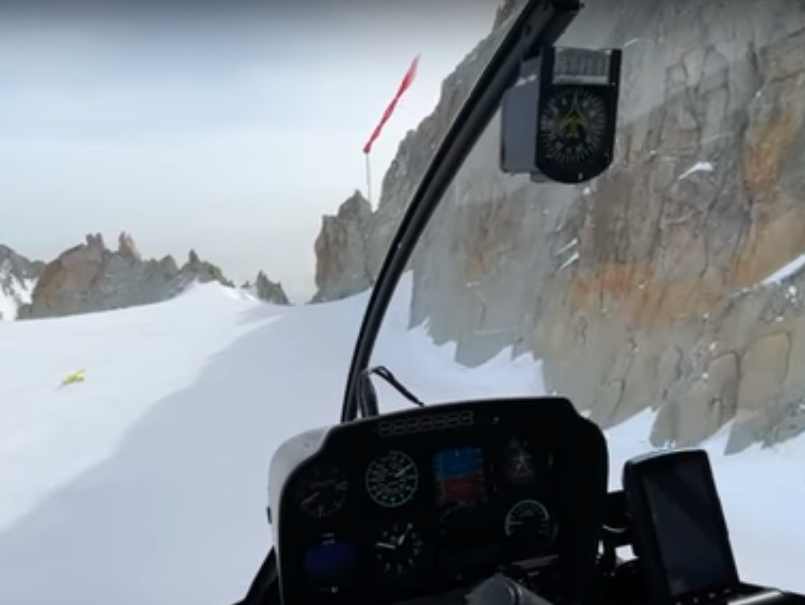
The behavior of the trim string is directly indicative of the airflow condition over the nose. Photo Credit: Vuichard Recovery Aviation Safety Foundation
Helicopters are particularly vulnerable to Vortex Ring State (VRS) during low-speed operations out-of-ground-effect. This could include operations such as external load work, power line inspection, rescue hoist operations and mountain approaches. Yet until recently, effective training to show pilots how to avoid VRS has been lacking.
The Vuichard Recovery Aviation Safety Foundation has released a new safety video on "How to avoid a Vortex Ring State in helicopter operations." This is a “must see” educational video for helicopter pilots that reveals new information for avoiding VRS as well as detecting a VRS in its earliest stages. There is a wealth of information in this video that is necessary for pilots, flight instructors, training program designers, human factors specialists and accident investigators to understand.
How good is this video? I watched it five times, vigorously taking notes each time. Throughout this learning process I called friends who have flown helicopters dating back to the Vietnam Era, pondering how this information eluded the industry for 50+ years. Nearly every aspect of this video contains information that has not been disseminated (nor properly explained) in helicopter training materials.
Loft Dynamics (formerly VRM Switzerland) arranged an in-person visit with Capt. Claude Vuichard in Zürich and generously provided usage of the H-125 flight training device. Vuichard demonstrated many of the lesson points while executing landings to sharp pinnacles and hovering in front of the famous North Face of the Eiger. Vuichard’s recovery resulted in a rapid recovery from the VRS with a minimal loss of altitude.
Trim String
Arguably the most informative feature of this educational video is the role of the trim string or “woolometer.” It is an important early warning sensor to avoid VRS. The behavior of the trim string is directly indicative of the airflow condition over the nose. It hangs straight down during hover and low speed flight due to the rotorwash’s prevailing downward motion. As a helicopter begins to pick up speed, the trim string rises. At 10 kts. of headwind, the trim string will deflect stably straight in the low disk loading category. It takes 20 kts. of headwind in a medium disk loading because the induced velocity from the rotor disk is stronger. Once the trim string rises steadily, the helicopter is outside of the VRS envelope.
The video has excellent illustrations of the trim string during normal operations and as a warning device to remain outside of the VRS envelope. Clearly this simple device has been under-appreciated, and yet it reveals accurate information of a helicopter’s airflow condition, especially at slow speeds when the pitot tube is inherently unreliable. During an approach it can indicate the influence of a crosswind.
As the helicopter slows perilously close to the edge of the VRS envelope, the trim string transitions from standing straight out to a random set of “nervous twitches.” This indication occurs prior to the other classic warning signs from the helicopter. This advanced warning can be invaluable, especially when the helicopter is operating close to the ground.
Several useful aspects of the trim string became apparent during our hands-on experience in Loft Dynamic’s H-125 flight training device in Zürich. The trim indicator is ideally situated in a pilot’s visual scan during approach and landing. It is located right on the nose and is easily viewed without the need for the pilot to rotate his or her eyes or head to view it. It is also far enough away from the eyes that an aging pilot who is slower at adjusting to far versus near images won’t have difficulty keeping the trim indicator in the visual scan.
It was also interesting to observe during our hands-on session that the VR technology simulated the changes in the trim string’s behavior throughout the flight envelope. This was evident while Vuichard demonstrated approaches to pinnacles, hovering in front of cliff faces and encounters with sudden downdrafts. This is a milestone in simulation technology, which enables systematic training to avoid and recover from VRS in different flight phases.
Vuichard strongly recommends that all rotorcraft manufacturers equip their helicopters with trim strings.
This is first of a three-part article series. The next part discusses descent rates.





